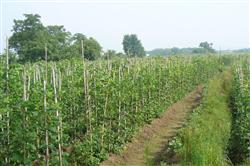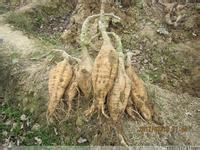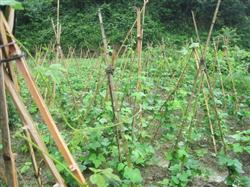Key points of cultivation of fast-growing Pueraria lobata

Pueraria lobata is a legume vine, the whole body is a treasure, the economic value is very high. Among them, kudzu powder is a characteristic health food, which integrates nutrition, dietotherapy and delicacy, and deep processing can also be made into more than a dozen kinds of exquisite food; kudzu leaf, which is rich in plant protein, belongs to full-price feed; Pueraria lobata is a valuable medicine and antialcoholic medicine. Pueraria lobata has the characteristics of short growth cycle and high yield. Now the variety characteristics and cultivation techniques of "fast-growing Pueraria lobata" are introduced as follows: first, the variety characteristics are large root tuber, thick stem, broad leaf surface and white fluff. Wide adaptability, adapt to all kinds of soil growth, resistant to drought and waterlogging, no diseases and insect pests. After planting, the stem nodes are full of kudzu every year, and the plant produces 10 kg-20 kg of Pueraria lobata. Second, the main points of cultivation techniques 1. Site selection. Barren hills and barren slopes with deep soil layers, riverside embankments, field corners, front and back houses can be planted. Weeds and shrubs, especially Pueraria lobata, should be strictly removed before cultivation. Because kudzu will affect the effective use of the ground, at the same time, when the root is harvested, such as mixed with Pueraria lobata, because its fiber is thick and hard, it will hold the crusher and can not be mechanized to make flour. 2. Digging ditches (holes) planting ditches (holes) are 30 cm-40 cm wide and 30 cm deep, and the distance between the two grooves (holes) is 1 m. 3. Planting. Plant seedlings (with roots) or cut seedlings (with 2 stem nodes, cuttable, without roots) in the planting period (February to late April) into the border ditch (hole), planting 650-700 plants per mu. Among them, the seedlings are planted at an oblique angle of 30 degrees from the ground, and the seedlings are cut into the soil at an oblique angle of 30 degrees, but the two stem nodes must be in the soil and the other outside the soil. After planting, pour the root water. 4. Growth management. After germination, it is appropriate to protect seedlings and apply fertilizer (rare manure), and it is appropriate to apply a small amount of fertilizer for many times. A mid-ploughing weeding and soil cultivation was carried out in mid-May (according to the actual situation). Because of its strong vitality, high coverage and strong nitrogen fixation, there is generally no need for ploughing and weeding. Appropriate amount of fertilizer should be applied every spring. 5. Root harvest. In winter, nutrients are concentrated in the root tuber, which causes the root tuber to expand rapidly. The soil at the base of the plant can be dug directly from the ground crack and the root tuber can be harvested. When harvesting, it is necessary to pick the big and leave the small, and cover the soil after harvest.
- Prev

Characteristics and artificial cultivation techniques of Wild Pueraria lobata
First, the characteristics. Pueraria lobata has strong adaptability, lax requirements on climate and geographical conditions, and is easy to cultivate. Suitable for warm and humid growing environment. Pueraria lobata likes warm and heat-resistant. It begins to germinate when the average daily temperature is about 12 ℃. The daily average temperature for growth is 20-33 ℃, 25-30 ℃ is suitable for root formation, and 15-20 ℃ is suitable for root formation.
- Next

Artificial planting of Pueraria lobata
Artificial planting Kudzuvine root suitable for wasteland, farmland, front, rear vegetable garden and other low-lying land planting. (i) Selection of good seeds. To shape high-yield kudzuvine root mainly, local folk cultivation species supplemented, absolutely do not seek trouble, plant wild kudzuvine and crude fiber local varieties. (ii) Plastic film seedling 1. Preparation of nutrient seedbed: select...
Related
- Fuxing push coffee new agricultural production and marketing class: lack of small-scale processing plants
- Jujube rice field leisure farm deep ploughing Yilan for five years to create a space for organic food and play
- Nongyu Farm-A trial of organic papaya for brave women with advanced technology
- Four points for attention in the prevention and control of diseases and insect pests of edible fungi
- How to add nutrient solution to Edible Fungi
- Is there any good way to control edible fungus mites?
- Open Inoculation Technology of Edible Fungi
- Is there any clever way to use fertilizer for edible fungus in winter?
- What agents are used to kill the pathogens of edible fungi in the mushroom shed?
- Rapid drying of Edible Fungi

